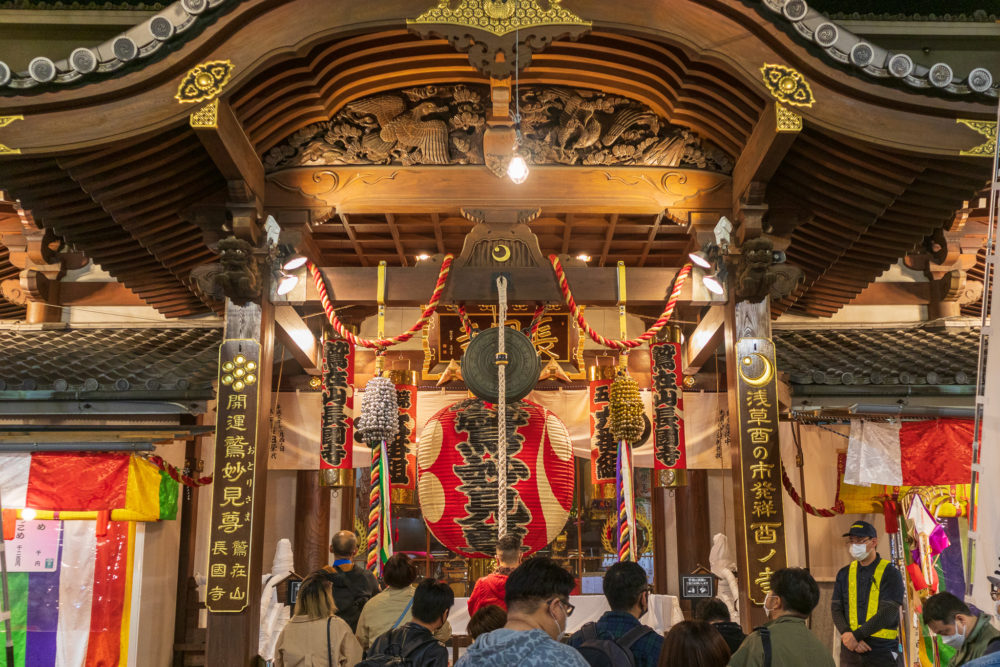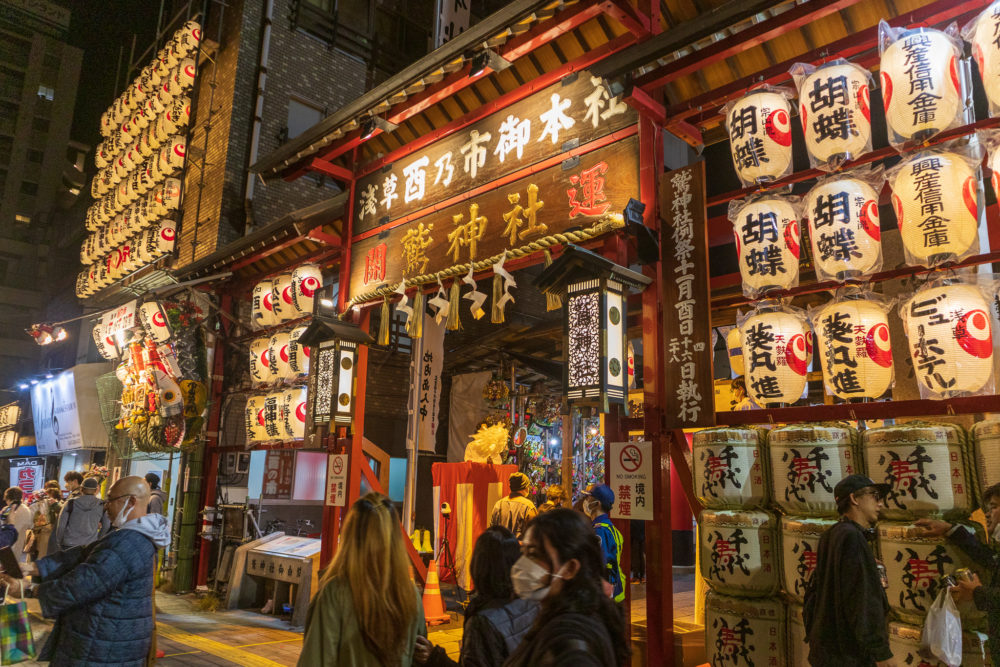The events category of our blog will cover limited-time events in the Shitamachi area of Tokyo. This time, we will pick Asakusa Tori-no-ichi Fair (the Rooster Day Market of Asakusa), a seasonal event in the Asakusa area.
Time flies quickly, and the year 2022 has less than two months left. Events to announce the end of the year have started here and there. Asakusa Tori-no-Ichi Fair (the Rooster-Day Market of Asakusa) is one of them.
Asakusa Tori-no-Ichi Fair is an annual event jointly held by Chokokuji Temple and Otori Shrine in Taito Ward of Tokyo. According to Wikipedia, this is the biggest Tori-no-Ichi Fair in Japan.
As the name suggests, Chokokuji Temple and Otori Shrine hold Asakusa Tori-no-Ichi Fair on rooster days every November. In 2022, the fair will be held on November 4th (Friday), 16th (Wednesday), and 28th (Monday).
This year, we went to Asakusa Tori-no-Ichi Fair on November 4th (Friday) after 1 am. This blog post will share what it was like.
We hope this blog post will help you somewhat when you visit Tokyo for sightseeing. If you have any questions, feel free to contact us through the contact form.
This blog post is also available in Japanese. You can refer to it at the following link:
What is Asakusa Tori-no-Ichi Fair?

Asakusa Tori-no-Ichi Fair is an annual event jointly held by Chokokuji Temple and Otori Shrine. This fair has the following purpose:
- to thank the god for this year’s safety.
- to pray to the god for happiness and prosperous business in the coming year.
There are two possible reasons why Chokokuji Temple and Otori Shrine hold Asakusa Tori-no-Ichi Fair together.
First, Otori Shrine was part of Chokokuji Temple until 1868. When the Meiji government issued the Shinbutsu-Bunri policy, Banshindo Hall at Chokokuji became an independent Shinto shrine as Otori Shrine. This policy strictly separates Shintoism from Buddhism.
Second, both Chokokuji Temple and Otori Shrine enshrine “O-Tori-sama” (Lord Tori). O-tori-sama at Chokokuji Temple is Washi-Myoken-Daibosatsu, a Buddhist deity. Ame-no-Hiwashi-no-Kami, a Shinto deity, is at Otori Shrine.
Event Dates

As mentioned above, Asakusa Tori-no-Ichi Fair will be held three times this year. The first day is called Ichi-no-Tori (the first rooster day), the second day is called Ni-no-Tori (the second rooster day), and the last day is called San-no-Tori (the third rooster day).
Asakusa Tori-no-Ichi Fair 2022
- Ichi-no-Tori (the 1st rooster day): November 4th (Friday)
- Ni-no-Tori (the 2nd rooster day): November 16th (Wednesday)
- San-no-Tori (the 3rd rooster day): November 28th (Monday)
Asakusa Tori-no-Ichi Fair 2023 (Expected Dates)
- Ichi-no-Tori (the 1st rooster day): November 11th (Saturday)
- Ni-no-Tori (the 2nd rooster day): November 23rd (Thursday)
Public Transport
Chokokuji Temple and Otori Shrine are both located along Asakusa-Kokusai-Dori Street. The nearby stations are as follows:
- 8 minutes on foot from Iriya Station (Exit #3) on the Hibiya Line
- 7 minutes on foot from Minowa Station (Exit #1b) on the Hibiya Line
- 10 minutes on foot from Asakusa Station (Exit A1) on the Hibiya Line
The Brief History

Interestingly, Chokokuji Temple and Otori Shrine claim the different origins of Asakusa Tori-no-Ichi Fair. This time, we’ll share a version from the Chokokuji Temple’s official website.
Chokokuji Temple is a Buddhist temple of the Honmon school of the Hokke sect, whose founder is Nichiren. One of the headquarters of this sect is Jusenji Temple in Chiba Prefecture.
In 1265, Nichiren spent some time at Jusenji Temple. When he was praying for national peace, he had a divine revelation from Washi-Myoken-Daibosatsu. According to Chokokuji Temple, it was a rooster day in November.
Washi-Myoken-Daibosatsu is one of the transformed forms of Myoken-Bosatsu; it holds a sword and rides on the back of an eagle. Myoken-Bosatsu is the god of war who deified the North Star and the Big Dipper.
In 1771, Nichigen, the 13th chief Buddhist priest of Chokokuji Temple, transferred the split spirit of Washi-Myoken-Daibosatsu from Jusenji Temple to Chokokuji Temple. This ritual is called Kanjo.
As previously stated, Nichiren received the divine revelation on a rooster day in November. For this reason, Chokokuji Temple opened the statue of Washi-Myoken-Daibosatsu to the public on rooster days in November every year. This is the very beginning of Asakusa Tori-no-Ichi Fair.
Why Has Asakusa Tori-No-Ichi Fair Become So Popular?

According to Wikipedia, this is the biggest Tori-no-Ichi Fair in Japan. It has from 700,000 to 800,000 visitors every year.
There are two main reasons why Asakusa Tori-no-Ichi Fair became so popular. The first reason was that it was very close to Asakusa. The second reason was that there was Yoshiwara Yukaku, a legal red-light district, in the neighborhood.
If you look at the map from the Edo period above, you will find Yoshiwara Yukaku near Chokokuji Temple and Otori Shrine.
Yoshiwara Omon Gate was normally the only entrance to Yoshiwara Yukaku. Chokokuji Temple was close to Yoshiwara Yukaku, but people had to take the long way to get to the gate from the temple.
On the days of Asakusa Tori-no-Ichi Fair, Yoshiwara Yukaku opened its back gate and other gates. People were able to enter Yoshiwara Yukaku without having to travel a long distance. For this reason, many people had fun at Yoshiwara Yukaku after visiting Asakusa Tori-no-Ichi Fair.
For more infomation about Yoshiwara Yukaku, please refer to the following blog post:
Folklores Related to Asakusa Tori-no-Ichi Fair
The Folklore About San-no-Tori (the 3rd Rooster Day)
“There are many fires in a year that has the third rooster day,” according to folklore. There are many hypotheses for this folklore.
As mentioned earlier, Yoshiwara Yukaku, a legal red-light district, was near Chokokuji Temple and Otori Shrine. As a result, many men went to Yoshiwara Yukaku, saying, “I’m going to Asakusa Tori-no-Ichi.” But their wives did not like it.
“You shouldn’t go to San-no-Tori because Yoshiwara Yukaku tends to catch fire on that day,” they told their husband to keep him from going to Yoshiwara Yukaku.





